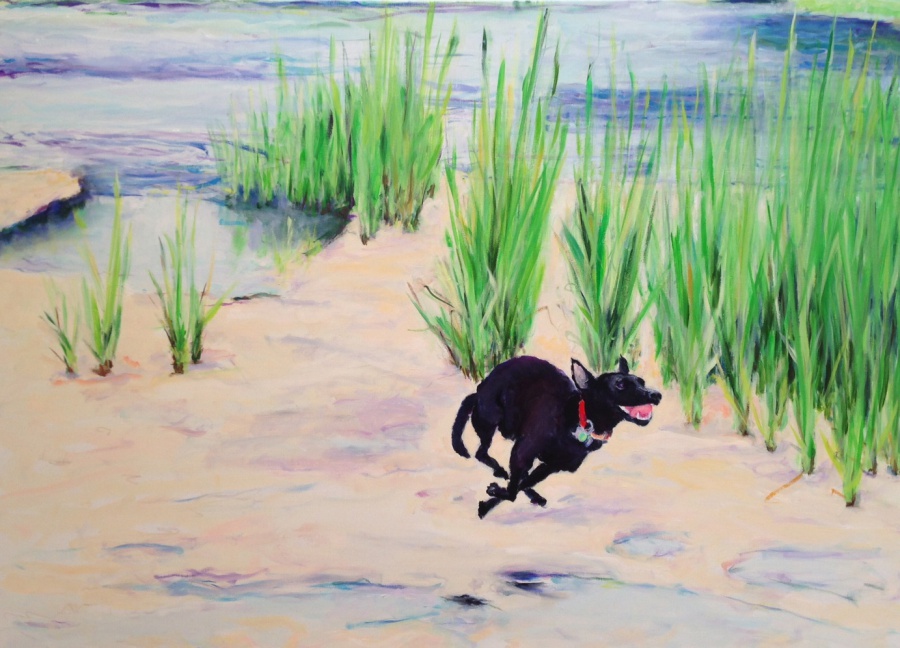Water Overflows with East End Artists at Tripoli Gallery in Southampton

The current show at Tripoli Gallery, “Water,” is themed as such. But what seems almost equally indicative of water, besides the numerous examples of artworks influenced by the element, is the curatorial fluidity; undoubtedly a challenge when the artwork ranges from a gilt-framed 1907 Thomas Moran to a 2013 conceptual work by multi-media artist Yung Jake comprised of three Fiji water bottles on a shelf and given an Emoji Icon title.
The viewer is quickly made aware of the ecological concerns behind the exhibition with a sculpture from neon-light pioneer Keith Sonnier’s “Tidewater Series,” Los La Butte, the first series in which the Louisiana-born artist used found objects in his work. Los La Butte has a yellow curving line of neon that extends the field of energy from within a lattice vortex, containing plastic bottles and debris, with an aluminum base made out of a washing machine tumbler. To the right of the sculpture is Stefan Bondell’s Missed the Mist, 2009; a canvas of blue topography resembling the ocean floor. In 2010, Bondell organized a poetry reading in the downtown New York Marble Cemetery, “Oil Kills Poets Spill,” featured a backdrop of one of his paintings, Currentcy, 20-by-20 feet large, and composed of shredded currency from the Federal Reserve, black and red ink, BP oil and blood, in direct commentary to the Gulf of Mexico oil spill.
Billy Sullivan’s Red on the Run captures the excitement of a dog off the leash at the bay. In a quintessentially Sullivan palette, the intense brightness of the sun is captured in stark whites in the sand and the water behind it. To the right is a crystal sculpture by Maya Lin, designer of the Vietnam Veterans Memorial, where her architectural background can be seen in the precision of the blue waves. Echoing the ripples of Lin’s Blue Wave are two photographs by Clifford Ross, whereby a clear body of softly moving water reflects overhead sunlight, temping us to dive in. Taken as abstractions, the variations in the repeated forms create movement within a fluid grid-like composition. To the right, the rippling water is seen in yet another form: a 1965 screen print and die-cut collage on blue Rowlux, a lenticular plastic that conveys a sense of movement when seen at different angles, entitled Seascape, by Roy Lichtenstein.
Remarkable groupings continue throughout: Darius Yektai’s The Shower, depicting a figure showering beneath a waterfall in a background of lush, tropical greenery is followed by two Ross Bleckner paintings, Black Monet I and Black Monet II, revealing beautiful pinks, yellows and reds of the lily flowers beneath a backdrop of blacks and greys.
Marsden Hartley’s Starfish, c. 1938, hangs adjacent to Willem de Kooning’s abstracted Sting Ray lithograph of 1971. Matisse Patterson’s intricate and curious Cornell-esque boxes include sand and water taken from local beaches, their titles, like Scott “The Cut” Cameron, revealing which one. A quietly peaceful Fairfield Porter, Beach, 1974, is flanked by a bright pink Mary Heilmann diptych and by a James de Pasquale quadtriptch—capturing Heilmann’s pinks and de Pasquale’s blue-greens.
Following the seascapes’ horizons we next encounter a Roy Lichtenstein print where diminishing dots simultaneously create depth and flatness, as his early-computer-graphic-trees add humor to the littoral scene. Lola Montes Schnabel’s mixed media adds excitement and brings us back to air after our metaphorical dive. Lastly, it seems worth noting that the oldest work, an 1890s William Merritt Chase, Shinnecock Bay, is side-by-side with the newest work, a 2013 Nathalie Shepherd diptych, Bathing Beauty in the City of New York and Waxed Up.
On view at Tripoli Gallery, 30A Jobs Lane, Southampton, through Sept. 9. Get more info at tripoligallery.com.



